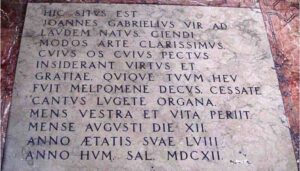Giovanni Gabrieli (1557-1612) Canzon septimi toni No. 2 from Sacrae Symphonie, 1597

Die Kathedrale von St. Markus ist das Juwel von Venedig. Pomp und Zeremonie waren unverzichtbarer Teil des Venezianischen Lebens und St. Markus spielte eine bedeutende Rolle in der Geschichte der Musik. Es muss daran erinnert werden, dass die antiphone Musik ihren größten Höhepunkt in Venedig erreichte. Das Prinzip des Wechsels von zwei Musikgruppen war ein dominierendes Element in der Musik von etwa 1580 bis 1630. Giovanni Gabrieli – venezianischer Kirchenmusiker am Markusdom in Venedig und einer der bedeutendsten Musiker der Venezianischen Schule am Übergang von der Renaissance hin zum Barock – erweiterte den mehrchörigen Stil sowohl hinsichtlich der Anzahl der Stimmen als auch der Anzahl der Chöre. Eines seiner bevorzugten Kunstgriffe ist die Schaffung eines Höhepunkts innerhalb eines Werks durch allmähliche Steigerung der rhythmischen Komplexität. Gabrielis Musik ein Idiom, das seinem Zweck und seiner Umgebung angemessen ist – einfach und doch großartig, stolz und doch andächtig. Die ursprüngliche Instrumentierung war nicht spezifiziert, und der Dirigent des 16. Jahrhunderts hätte zwischen Zinken, Violinen, Gamben, Posaunen, Fagotten und Orgeln wählen können. Mit dem heutigen Instrumentarium eignet sich Gabrielis doppelchörige Musik ideal für ein Blechbläserensemble in einer variablen Besetzung mit Trompeten, Hörnern, Posaunen und Tuben.

Grave slab of Giovanni Gabrieli in Venice. “Here lies Giovanni Gabrieli, a man born for (God) praise. Most famous in the art of sounding music… In the month of August on the 12th day – At his age of 58 – 1612″
The Cathedral of St. Mark is the jewel of Venice. Pomp and ceremony were an integral part of Venetian life and St. Mark played an important role in the history of music. It must be remembered that antiphonal music reached its greatest peak in Venice. The principle of alternating two choirs was a dominant element in music from about 1580 to 1630. Giovanni Gabrieli – Venetian church musician at St. Mark’s Basilica in Venice and one of the most important musicians of the Venetian school at the transition from the Renaissance to the Baroque – expanded the polychoral style in terms of both the number of voices and the number of choirs. One of his favorite artifices is the creation of a climax within a work by gradually increasing rhythmic complexity. Gabrieli’s music is an idiom befitting its purpose and environment – simple yet grand, proud yet reverent. The original instrumentation was not specified, and the 16th-century conductor could have chosen from cornetts, violins, viols, trombones, bassoons and organs. With today’s instruments, Gabrieli’s double-choir music is ideal for a brass ensemble in a variable instrumentation with trumpets, horns, trombones and tubas.
| sound sample / Tonbeispiel | score/parts PDF download: € 39,- | add to cart / in den Warenkorb |
